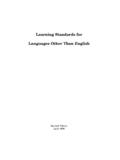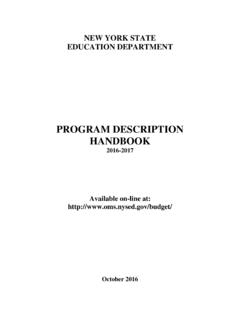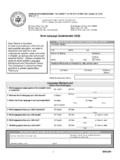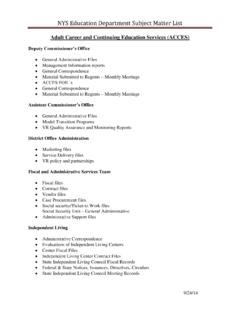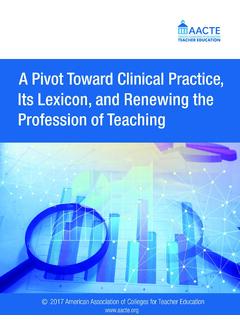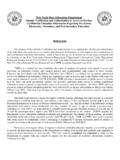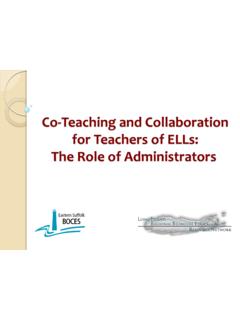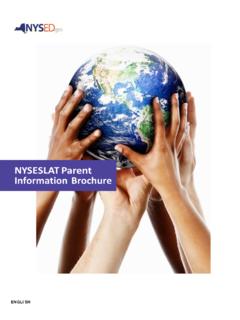Transcription of NYSED Kindergarten ELA Crosswalk (2017) Original 2011 ELA ...
1 NYSED Kindergarten ELA Crosswalk ( 2017 ). Original 2011 ELA Standard 2017 Revised ELA Standard Standard Code (2011). KRF1 Demonstrate understanding of the KRF1: Demonstrate understanding of the organization and basic features of print. organization and basic features of print. a. Follow words from left to right, top to KRF1a: Follow words from left to right, top to bottom, and page by page. bottom, and page by page. b. Recognize that spoken words are KRF1b: Recognize that spoken words are represented in written language by represented in written language by specific specific sequences of letters. sequences of letters. c. Understand that words are separated KRF1c: Understand that words are separated by by spaces in print.
2 Spaces in print. d. Recognize and name all upper- and KRF1d: Recognize and name all upper- and lowercase letters of the alphabet. lowercase letters of the alphabet. KRF1e: Identify the front cover, back cover, and title page of a book. Note: This connects to PKRF1g, but includes title page of a book in Kindergarten . KRF2 Demonstrate understanding of spoken KRF2: Demonstrate understanding of spoken words, syllables, and sounds (phonemes). words, syllables, and sounds (phonemes). a. Recognize and produce rhyming words. KRF2a: Recognize and produce spoken rhyming b. Count, pronounce, blend, and segment words. syllables in spoken words. KRF2b: Blend and segment syllables in spoken c.
3 Blend and segment onsets and rimes of words. single-syllable spoken words. KRF2c: Blend and segment onsets and rimes of d. Isolate and pronounce the initial, medial spoken words. vowel, and final sounds (phonemes) in KRF2d: Blend and segment individual sounds three-phoneme (consonant-vowel- (phonemes) in spoken one-syllable words. consonant, or CVC) words.* (This does KRF2e: Create new words by manipulating the not include CVCs ending with /l/, /r/, or phonemes orally in one-syllable words. /x/.). e. Add or substitute individual sounds (phonemes) in simple, one-syllable words to make new words. KRF3 Know and apply grade-level phonics and KRF3: Know and apply phonics and word word analysis skills in decoding words.
4 Analysis skills in decoding words. a. Demonstrate basic knowledge of one- KRF3a: Demonstrate one-to-one letter-sound to-one letter-sound correspondences correspondence by producing the primary by producing the primary sound or sound or most frequent sound for each many of the most frequent sounds for consonant. each consonant. KRF3b: Decode short vowel sounds with b. Associate the long and short sounds common spellings. with common spellings (graphemes) for KRF3d: Read common high-frequency words by the five major vowels. sight words. c. Read common high-frequency words by KRF3c: Decode some regularly spelled one- sight ( , the, of, to, you, she, my, is, syllable words.)
5 1. NYSED Kindergarten ELA Crosswalk ( 2017 ). Original 2011 ELA Standard 2017 Revised ELA Standard Standard Code (2011). are, do, does). d. Distinguish between similarly spelled words by identifying the sounds of the letters that differ. KRF4 Read emergent-reader texts with purpose KRF4: Read or explore emergent-reader texts and understanding. with sufficient accuracy to support comprehension. KR1 RL: With prompting and support, ask and KR1: Develop and answer questions about a answer questions about key details in a text. (RI&RL). text. RI: With prompting and support, ask and answer questions about key details in a text. KR2 RL: With prompting and support, retell KR2: Retell stories or share key details from a familiar stories, including key details.
6 Text. (RI&RL). RI: With prompting and support, identify the main topic and retell key details in a text. KR3 RL: With prompting and support, identify KR3: Identify characters, settings, major events characters, settings, and major events in a in a story, or pieces of information in a text. story. (RI&RL). RI: With prompting and support, describe the connection between two individuals, events, ideas, or pieces or information in a text. KR4 RL: Ask and answer questions about KR4: Identify specific words that express unknown words in a text. feelings and senses. (RI&RL). RI: With prompting and support, ask and answer questions about unknown words in a text.
7 KR5 RL: Recognize common types of texts ( , KR5: Identify literary and informational texts. storybooks, poems). (RI&RL). RI: Identify the front cover, back cover, and title page of a book. KR6 RL: With prompting and support, name the KR6: Name the author and illustrator and define author and illustrator of a story and define the role of each in presenting the ideas in a text. the role of each in telling the story. (RI&RL). RI: Name the author and illustrator of a text 2. NYSED Kindergarten ELA Crosswalk ( 2017 ). Original 2011 ELA Standard 2017 Revised ELA Standard Standard Code (2011). and define the role of each in presenting the ideas or information in a text.
8 KR7 RL: With prompting and support, describe KR7: Describe the relationship between the relationship between illustrations and illustrations and the text. (RI&RL). the story in which they appear ( , what moment in a story an illustration depicts). RI: With prompting and support, describe the relationship between illustrations and the text in which they appear ( , what person, place, thing, or idea in a text an illustration depicts). KR8 RL: (Not applicable to literature) KR8: Identify specific information to support ideas in a text. (RI&RL). RI: With prompting and support, identify the reasons an author gives to support points in a text.
9 KR9 RL: With prompting and support, compare Omitted. See KR9 ( 2017 ) for connections and contrast the adventures and between texts. KR9: Make connections experiences of characters in familiar between self, text, and the world. (RI/RL). stories. a. With prompting and support, students will make cultural connections to text and self. RI: With prompting and support, identify basic similarities in and differences between two texts on the same topic ( , in illustrations, descriptions, or procedures). KR10 RL: Actively engage in group reading Please see the Range of Student Reading activities with purpose and understanding. Experiences for Kindergarten section included in the introduction to the Kindergarten RI: Actively engage in group reading Standards.
10 Activities with purpose and understanding. KR11 RL: With prompting and support, make KR9: Make connections between self, text, and connections between self, text, and the the world. (RI/RL). world around them (text, media, social interaction). RI: Not applicable to Reading for Information Standard 3. NYSED Kindergarten ELA Crosswalk ( 2017 ). Original 2011 ELA Standard 2017 Revised ELA Standard Standard Code (2011). KW1 Use a combination of drawing, dictating, KW1: Use a combination of drawing, dictating, and writing to compose opinion pieces in oral expression, and/or emergent writing to which they tell a reader the topic or the state an opinion about a familiar topic or name of the book they are writing about personal experience and state a reason to and state an opinion or preference about support that topic.
